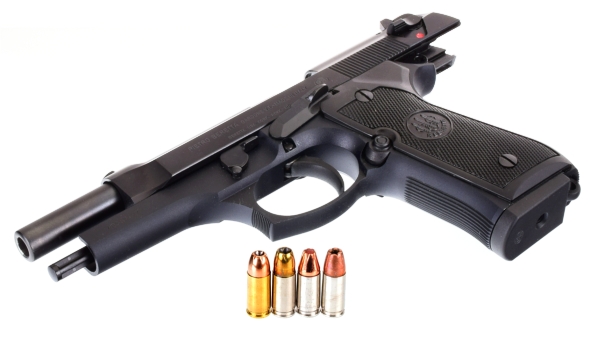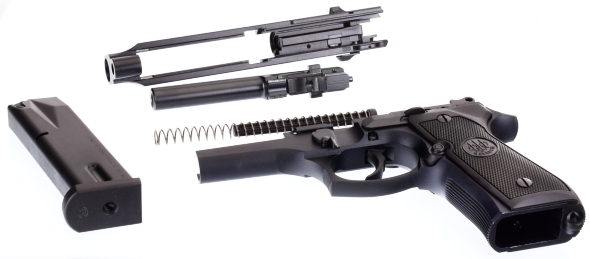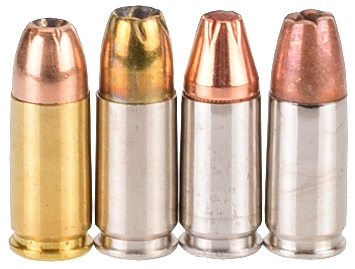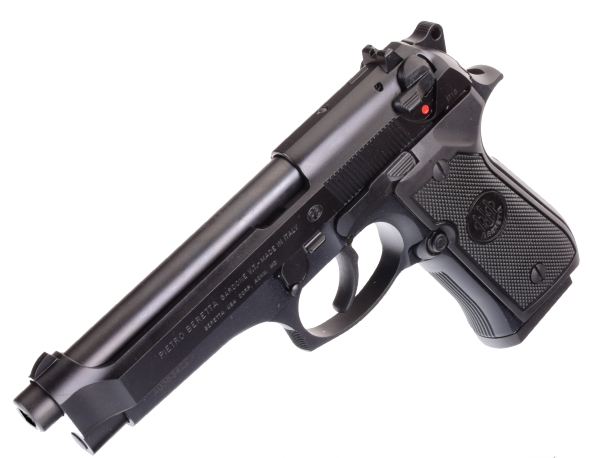
We had a mild winter going and then the nearly daily snow storms arrived. Still, work waits for no one so we wrapped up this final Beretta installment with a few inches of snow accumulating, snow falling hard and temps in the single digits. Fortunately, we use LED illuminated chronograph sky screens so, from an outdoor overhead shelter, ambient daylight is optional.
+P or not +P, that is a question…
The Beretta manual’s statement on ammunition….
“The pistol is designed and tested to withstand continued shooting with all brands and
types of commercial ammunition manufactured to standard (C.I.P., S.A.A.M.I., etc.) specifications. We do not recommend extended use of +P, +P+ or submachine gun ammunition because the chamber pressure may reach or exceed proof load pressure decreasing the major components service life expectancy. The warranty does not cover the use of reloaded and/or hand loaded ammunition”,
…and then goes on to offer cautions to people who do shoot reloaded ammunition, mostly in regard to the use of cast lead bullets and bore fouling. So what does all of this mean?
|
Piezo Conformal Transducer Method PSI |
||||
| Cartridge | SAAMI | CIP | NATO | Max Proof |
| 9mm Luger | 35000 | 34084 | 33359 | 55000 |
| 9mm Luger +P | 38500 |
– |
– |
55000 |
|
9mm NATO (9x19mm) Stanag 4090 CUP is rated 36,985 CUP, not PSI, whichhas no correlation to transducer method which renders the rating irrelevant. |
||||
The Beretta barrel is marked PB – 9 x 19 to signify Para Bellum 9 x 19mm. The CIP record dated June 14, 1984, revised September 23, 2008 designates the cartridge name 9mm Luger, with Germany credited as the country of origin. The pressure specification is stated as 2350 BAR, a metric unit of measurement, often converted to 34,084 PSI. CIP does not have a +P designation for ammunition. The Beretta Model 92 FS is approved for use with all CIP certified ammunition.
The SAAMI U.S. standards group name of record for this cartridge is the 9mm Luger and published two SAAMI pressure specifications, the 9mm Luger and the 9mm Luger +P as noted above on the table. Based on the design and materials and processes employed in the manufacturer of the pistol, SAAMI certified 9mm Luger ammunition should be the routine diet for the M 92FS, however, the occasional use of +P ammunition is acceptable and will lead to accelerated wear. There is no +P+ standard. The designation is a manufacturer’s created designation and meaningless in judging ammunition suitability.
The 9mm NATO is not a C.I.P. or SAAMI designation, it is a military specification, much like the 223 Remington versus 5.56 NATO. The 9mm NATO is not a hot version of the 9mm Luger, it is a mild version of the 9mm Luger with a lower pressure rating. There is a NATO specification stated in CUP, Copper Units of Pressure, the result of copper crusher pressure estimating methodology. Modern pressure ratings are stated as PSI or BAR, the result of Piezo transducer testing. Some folks see a 36,985 CUP rating for the 9mm NATO, they don’t understand the difference, and hit the gun forums with this new “wisdom” that the 9mm NATO pressure standard is 36,985 PSI. Not the case.
The Beretta’s reliability… further off the road adventure
I always like news agencies that report the news, I care little for those that feel compelled to explain the news as the latter almost always modifies the news to fit an agenda. These are the reports that are often plagiarized and misinterpreted. I you have an interest in the subject, read them:

My conclusion? Military procurement is political, corrupt and poorly executed. The contract was large and the relationship with competing manufacturers contentious; before, during and after the award. Lot acceptance testing and failure analysis was lacking in definition and control. In the end, consensus was found in identifying and correcting found problems. Small cracks in the M9’s frame, right hand side near the top center of the grip were found to be cosmetic and created during the manufacturing process. A change was made in 1988 that altered the process and resolved the problem. As a practical matter, there were zero field frame failures reported with 100,000 plus units in service.
The 1989 report shows a total of three field slide failures were experienced by Navy Special Warfare Forces where ammunition was suspect. Eleven slides failed in poorly controlled laboratory testing. Again, read the reports for yourself, keep in mind the millions of Berretta Model 92 pistols in military, law enforcement and civilian service and arrive at your own conclusions. The military’s primary concern was retention of the failed slide rather than slide failures. In 1989, the Model 92’s hammer pin was enlarged to act as a retainer in the event of slide failure.
Of note was the mandatory bid requirement of a 5,000 round service life pistol with a desire for a 10,000 service life. The mandated service life works out to approximately two years for a 50 round per week shooter and 8 years for a 50 round per month shooter, however, reading through the indicated reports, the pistol seems to hold up for many above the 30,000 round mark . Beretta’s warranty is one year parts and labor for the original owner, three years if the pistol is registered for warranty within 30 days of purchase.
A little less conversation, a little more action…

|
Ammunition |
Type | Weight Grains |
Rated Velocity FPS |
Recorded Velocity FPS |
50 Ft 3 Shot Group” |
| PMC Bronze | JHP | 115 | 1160 | 1148 | 2.0 |
| Remington Ultimate Defense | BJHP | 124 | 1100 | 1142 | 1.4 |
| Hornady Critical Duty +P | Flexlock | 135 | 1115 | 1083 | 1.8 |
| Winchester Train & Defend | JHP | 147 | 950 | 1020 | 1.7 |
The difference in velocity between rated and recorded velocity is about the same by ammo type across a good number of 9mm autoloaders reviewed. The CIP test barrel length for pistols is 5.9″, the SAAMI barrel length is 4″. Hornady and Winchester test with a 4″ barrel. The Beretta has a 4.9″ barrel. Accuracy was good and reliability, after heavy shooting over a period of 2 days, was flawless.
Shooting impressions? Sure, this is me as Ed McGivern
The Beretta in very well balanced, settling comfortably in the hand, but it feels… or maybe looks longer than it is; maybe the open slide? Control placement is great, everything from trigger reach to safety/decocker, slide catch and mag release. The sights are very good; a three dot system. The rear notch is wide, which helps to get on any target quickly. Double action pull is long and heavy, but uniform in resistance and quite easy to keep on target while the trigger finger makes the journey. Single action pull is very light, pretty much devoid of creep and overtravel. Recoil is very light, despite the ammunition fired. The Beretta Model 92 FS is a very good full 9mm size auto.


Email Notification